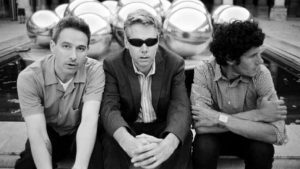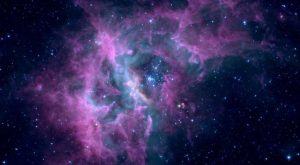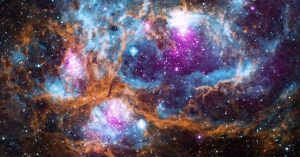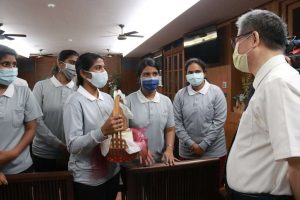The 21st Vow: a buddha-like body with 32 physical characteristics
Amitabha’s 21st Vow is addressed to all human and heavenly beings. It states:
If, when I attain Buddhahood, humans and devas in my land should not all be endowed with the thirty-two physical characteristics of a Great Man, may I not attain perfect Enlightenment.
The 32 physical characteristics denote a Transformed Buddha, like Shakyamuni Buddha, who appeared in human form in this transformed and defiled land. These characteristics are formed as the rewards of Shakyamuni’s diligent practice of virtue in the threefold karma during his past lives.
As Shakyamuni Buddha accomplished buddhahood in the transformed land (our world) about 2,600 years ago, he is regarded as a Transformed Buddha, or the appearance of undifferentiated buddha-nature when manifesting in a physical body. In Sanskrit, this body is known as the Nirmanakaya. This is one of the three bodies possessed by every buddha.
Briefly, the three bodies are:
The Dharmakaya: undifferentiated buddha-nature that is beyond all conceptualizations and categories;
The Sambhogakaya: the non-material buddha body, which manifests in a non-material pure land for the benefit of bodhisattvas, deities, and other beings who are reborn there; and:
The Nirmanakaya (already mentioned): the physical body that manifests in the Saha world for the benefit of humans and all sentient beings.
Although all buddhas have the threefold body, human beings can recognize a buddha only through his Nirmanakaya. So when the 21st Vow tells how all beings in that land possess the 32 characteristics, it is telling us that we will become perfectly enlightened Bbuddhas like Shakyamuni when we are reborn in the Land of Bliss.
Moreover, from the moment of accomplishing Buddhahood, people are uninhibited in the ways they were as human beings. With a Buddha’s body, they can freely return to this Saha world and work to deliver all sentient beings, just like Shakyamuni.
Two other vows related to the bodies of living beings in the Land of Bliss
There are two other vows related to the bodies of living beings in the Land of Bliss—namely, the Third and 26th Vows. The Third Vow states:
If, when I attain Buddhahood, humans and devas in my land should not all be the color of pure gold, may I not attain perfect Enlightenment.
This means that the bodily color of devas and humans in the Land of Bliss is the same as that of Amitabha Buddha. (In addition, Amitabha Buddha also possesses 84,000 physical characteristics, each having 84,000 secondary marks of excellence, according to the Contemplation Sutra.)
The 26th Vow states:
If, when I attain Buddhahood, there should be any bodhisattva in my land not endowed with the body of the Vajra-God Narayana, may I not attain perfect Enlightenment.
Narayana is one of the devas or heavenly beings known in the East. He is like Hercules in that he is endowed with great strength and cannot be defeated.
Narayana’s body is hard as a diamond, which is indestructible. He suffers no aging, no illness, and no death. Narayana is a Dharma-protecting deity but is also regarded as a bodhisattva. So excellent is his form and strength that Amitabha Buddha vows to bestow those bodhisattvas who wish to be reborn in the Land of Bliss with bodies as strong as Narayana’s.
Bodily appearance of living beings in the Land of Bliss
What is the actual bodily appearance of living beings in the Land of Bliss? Let’s review an important passage from the Infinite Life Sutra. It says:
That Buddha-land, like the realm of unconditioned Nirvana, is pure and serene, resplendent, and blissful.
The shravakas, bodhisattvas, heavenly beings, and humans there have lofty and brilliant wisdom, and are masters of the supernatural powers. They are all of one form, without any differences, but are called “heavenly beings” and “humans” simply by analogy with the states of existence in other worlds.
They are of noble and majestic countenance, unequaled in all the worlds, and their appearance is superb, unmatched by any being, heavenly or human. They are all endowed with bodies of Naturalness, Emptiness, and Infinity.
From this, we can see that all beings in the Land of Bliss are of one form, without any differences between them. They are all endowed with bodies of Naturalness, Emptiness, and Infinity. Why? It is because the Land of Bliss is a realm of unconditioned Nirvana. It was also taught by Vasubandhu Bodhisattva that “[The Land of Bliss] is a realm of virtuous roots of the Mahayana.”
What is meant by “analogy with the states of existence in other worlds”? This phrase is intended to point out the equality of the beings in the Land of Bliss. “Other worlds” include the Land of Saha where Skakyamuni Buddha speaks the Dharma. The beings who are named according to their states in these other worlds include shravakas, bodhisattvas, devas, and humans.
If they are named only “by analogy,” this means the bodily appearance of all inhabitants is actually the same. They all enjoy bodies of Naturalness, Emptiness, and Infinity. It is inconceivable, isn’t it? You can imagine whatever you like, not just the 32 physical characteristics and 80 marks of excellence.
You can have the same bodily appearance as Amitabha Buddha with 84,000 physical characteristics, each having 84,000 secondary marks of excellence. Each of these marks has 84,000 rays of light that permeate all the worlds of the ten directions, as taught in the Contemplation Sutra.
Here, we should understand that, in Buddhist texts, 84,000 is a number denoting infinity. To be born in the Land of Bliss is to be born in the home of all buddhas, as stated in the Contemplation Sutra. Each buddha exists in a state of perfect oneness with all other buddhas, their unity filling the vastness of the Dharma realm with an infinite variety of virtues, blessings, and light.
Endowed with a Body of Naturalness, Emptiness, and Infinity in the Form of Light
It should be noted that all inhabitants in the Land of Bliss exist in the form of “light.” They can appear in any shape and size they wish for the purpose of delivering sentient beings under any circumstance. This is an inconceivable and awesome supernatural power endowed by Amitabha Buddha.
It is also an expedient means to attract sentient beings of different aptitudes and capacities, like shravakas, bodhisattvas, heavenly beings, and human beings, to aspire to be reborn in the Land of Bliss.
Although they are categorized by their status in former worlds, in the Land of Bliss they enjoy the same wisdom and power.
Related features from BDG
Why Did Amitabha Buddha Make the 19th and 20th Vows for Sentient Beings Who Aspire to Be Reborn in the Land of Bliss?
Master Shandao’s Interpretation of Amitabha’s 20th Vow of Deliverance
Master Shandao’s Interpretation of Amitabha’s 19th Vow of Deliverance













Dear Alan,
Big thanks for Your work and insight on Buddha Dharma teachings. I was wondering if You could also implement real testimonies of people who actually used the vehicle of Amitabha recitation and had successful rebirth in Sukhawatti/Dewachen? This I think is very appealing method to inspire most practicioners to use methods of Pureland School.